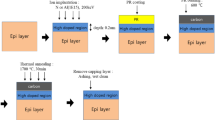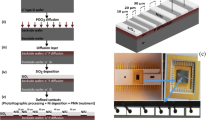Abstract
The thermal stability of COSi2 for thermal budgets suitable for a self-aligned P+ gate MOSFET process using rapid thermal processing was studied. The substrate underlying the suicide has a major impact on suicide degradation. Suicides formed on as-deposited amorphous silicon films and on single crystal Si were found to be stable at least up to 1000°C, whereas suicides formed on as-deposited polysilicon (i.e. conventional polycide) began to degrade at annealing temperatures greater than 800°C. BF2-implant dosages of 1×1015 cm-2 to 2×1016 cm-2 at 20keV in the suicide were found to affect the conventional polycide significantly. With higher implant dosages, the degradation of the conventional polycide is retarded for a 900°C anneal. However, for thermally stable suicides i.e., suicides formed on as-deposited amorphous Si and on single crystal Si, a high dose 2×1016 cm-2 implant increases the sheet resistance slightly from 1.4 Ω/square to 1.6 Ω/square for suicides on as-deposited amorphous Si substrate, and from 1.3 Ω/square to 1.6 Ω/square for suicides on single crystal substrates. A model which involves spheroidization of the suicide, silicon incursion, and indiffusion of Co into polysilicon is proposed to explain the degradation behavior.
Similar content being viewed by others
References
C. L. Chu, G. Chin, K. C. Saraswat, S. S. Wong, R. Dutton, IEEE Elec. Dev. Lett. 12, 696 (1991).
J. R. Phillips, P. Revesz, J. O. Olowolafe, and J. W. Mayer, in Polysilicon Thin Films and Interfaces, edited by B. Raicu, T. Kamins, and C. V. Thompson (Mater. Res. Soc. Proc. 182, Pittsburgh, PA 1990) pp. 57–63.
S. P. Murarka, C. C. Chang, and A. C. Adams, J. Vac. Sci. Technol. B, 5, 865 (1987).
S. Nygren and S. Johansson, J. Vac. Sci. Technol. A, 8, 3011 (1990).
P. Lippens, K. Maex, L. Van den Hove, R. De Keersmaecker, V. Probst, W. Koppenol, and W. van der Weg, J. De Physique, Col. C4, 49, 191 (1988).
S. Vaidya, S. P. Murarka, and T. T. Sheng, J. Appl. Phys., 58, 971 (1985).
C. Lu, J. J. Sung, R. Liu, N. Tsai, R. Singh, S. J. Hillenius, and H. C. Kirsch, IEEE Trans. Elec. Dev., 38, 246 (1991).
V. Probst, H. Schaber, A. Mitwalsky, H. Kabza, B. Hoffmann, L. Van den hove, and K. Maex, J. Appl. Phys., 70, 708 (1991).
Author information
Authors and Affiliations
Rights and permissions
About this article
Cite this article
Chen, W., Lin, J., Banerjee, S. et al. Thermal Stability of Cobalt Disilicide for Self-Aligned Silicide Applications. MRS Online Proceedings Library 260, 163–167 (1992). https://doi.org/10.1557/PROC-260-163
Published:
Issue Date:
DOI: https://doi.org/10.1557/PROC-260-163




